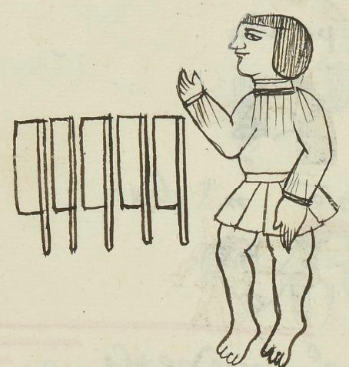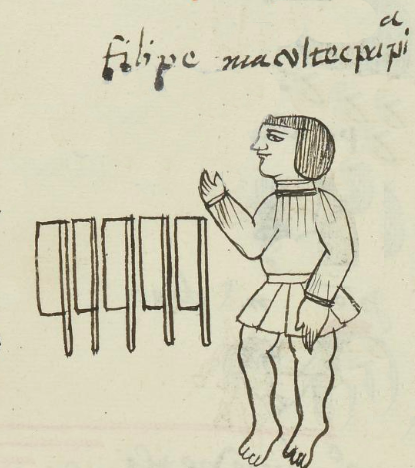macuiltecpanpia (MH593r)
This black-line drawing of the simplex glyph for the the name and/or occupation macuiltecpanpia (“keeper of 100,” attested here as a man’s job) shows a 3/4 view of a barefooted Indigenous man in European-type clothing, with his right arm raised, his left arm hanging at his side, and his legs slightly separated. His posture suggests movement. To the left of him are five upright, rectangular banners, facing to the left. Each flag represents 20 people (tribute payers, who often represent a couple and sometimes small children) who are under the watch of this man.
Stephanie Wood
The number 100 may suggest the increasing influence of the decimal system that was introduced through Spanish colonialism. However, the counting by twenties (here, five twenties) shows some life clearly remaining in the vigesimal system, and counts of 100 were possible in the old system.
Stephanie Wood
filipe macvltecpapia.
Felipe Macuiltecpanpia
Stephanie Wood
1560
Jeff Haskett-Wood
numbers, números, tributarios, jefe, cinco por veinte, mapilhuia, mahpilhuia, señalar con el dedo

macuil(li), five, https://nahuatl.wired-humanities.org/content/macuilli
tecpana, to put in rows, https://nahuatl.wired-humanities.org/content/tecpana
tecpan(tli), 20, or a row, https://nahuatl.wired-humanities.org/content/pantli
pia, to keep or guard, https://nahuatl.wired-humanities.org/content/pia
mapilhuia, to point a finger, https://nahuatl.wired-humanities.org/content/mapilhuia
Él Guarda Cien Personas
Stephanie Wood
Matrícula de Huexotzinco, folio 593r, https://www.loc.gov/resource/gdcwdl.wdl_15282/?sp=265&st=image
This manuscript is hosted by the Library of Congress and the World Digital Library; used here with the Creative Commons, “Attribution-NonCommercial-ShareAlike 3.0 License” (CC-BY-NC-SAq 3.0).


